Above: Simple pleasures achieve the sublime at Vallecitos Mountain Retreat Center.
FOR LONG MOMENTS the sight holds us mesmerized: diamonds and ripples of golden light reflecting off the river and skittering back and forth on the overhanging rock, shadows pulsing in time. No one says a word—we’ve scarcely spoken at all for the week we’ve been together. If we had been chattering down the trail we probably would have hurried right past this scintillating light show. But really, what is there to say? The fullness of the moment is enough. And of the moment after, and the one after that.
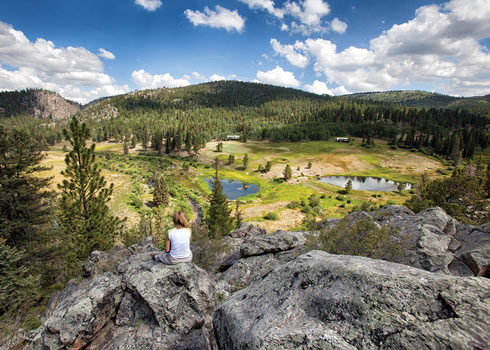 A peaceful vantage over the lodge and the Rock Creek ponds.
A peaceful vantage over the lodge and the Rock Creek ponds.
It was a lesson learned well by the 16 of us who’d come for a spring retreat at the Vallecitos Mountain Retreat Center in the wilds of New Mexico’s Tusas Mountains. Each day we drank deeply of the mountain air, nourished in body by healthy meals and in spirit by timeless spells of meditation in the lodge and on the trails. We came to unplug from electronic devices and leave behind busy schedules so we could focus our awareness, sharpen our senses, and better take in the beauty, complexity, and richness of the natural world. Such directed, quiet attention seldom happens in the hectic urban world where most of us make our homes. In coming here, we were answering to a yearning that’s increasingly common in today’s society.
This 132-acre retreat center, surrounded by 300,000 acres of the Carson National Forest, was first defined as private property in 1898, when a homesteader named Thomas Sibley claimed it. When he laid eyes on the sloping meadow along the Vallecitos River, though, Sibley wasted little time gazing at reflections on rock faces. He was no doubt more concerned with how the land might support his family. And as he sized up the grazing potential, looked for springs he could tap for drinking water, and scanned for a suitable cabin site, his assessment couldn’t have been too upbeat: At an elevation of 8,800 feet in far northern New Mexico, this small valle offered almost no possibility for growing food, only a short summer season to make hay—and a long winter to just hang on.
Sibley did hang on, for a dozen years or so, and his homestead cabin, hand-dug well, and barn remain. But now a large, comfortable lodge sits at the far edge of the meadow, and behind it a cluster of 19 small cabins and four yurts, half hidden in aspens. Black solar panels outside each structure face south to catch sunlight, and the small creek running along the meadow spills through seven man-made ponds before emptying into the Vallecitos River. It’s a perfect setting for the reflective experience of nature and self.
Clearly, in the time that has passed since Sibley filed his homestead application, perceptions of this landscape have changed dramatically, from utilitarian to utopian. But people were utilizing this land, and projecting onto it their ideas about nature, long before homesteaders flooded over the West.
A 2,000-year-old stone arrowhead found on the property reveals that people passed through at least two millennia ago. We can imagine their conception of the place by considering the views of Ute, Jicarilla Apache, Puebloans, and other Native people in more recent times. For them, the Tusas Mountains were a place for hunting game and gathering medicinal and food plants. But they also regarded the mountains, like all of nature, as animate, full of portents and populated not only by wildlife but by monster-like characters and deities. The mountains held sacred sites of pilgrimage and were important actors in cosmology and everyday life.
Ten steps down the trail, our snail-pace progress halted again, all eyes turn to the brilliant yellow-orange-and-black bird perched overhead. No one rushes to name it, photograph it, or check it off a life list of bird sightings. We take in the splendid vision of the tanager against dark spruce boughs, then move on in silence.
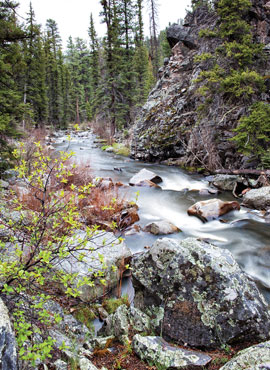 The Vallecitos River in springtime.
The Vallecitos River in springtime.
Native people didn’t map hard lines of ownership onto the landscape. That kind of tenure began in the Tusas in 1832, when Mexican authorities issued the Tierra Amarilla Land Grant to settlers from Abiquiú. The eastern boundary of the immense grant (594,515 acres) reached almost to Sibley’s homestead. The uplands of this and other grants in New Mexico were considered ejidos, common lands to be used by all members of the community. But Mexicans had little opportunity to access the Tierra Amarilla grant because, in 1841, Americans took over New Mexico and legal maneuvers by land speculators led to the alienation of the communal lands from the rightful heirs. When the Denver and Rio Grande Railway laid tracks into the area in 1880, leases were offered on the appropriated grant lands and the first large-scale exploitation of the mountains began, with no regard for the effects on the land.
These newcomers to the mountains saw them as a place to extract resources that could be converted into cash. Beaver had already been trapped out, and commercial hunters had depleted or eliminated deer, elk, and mountain sheep. Now timber companies voraciously cut down the old-growth ponderosa pines and Douglas firs, shipping them out at railroad towns like Tres Piedras, 30 miles by road east of the Vallecitos homestead, and Chama, 50 miles northwest. Cattle and sheep ranchers, too, relied on the railroad to ship livestock out in numbers never before seen.
Gold fever also was at its peak, bringing in droves of people who, knowing of the spectacular success of mining operations just north in Colorado’s San Juan Mountains, scoured the Tusas. There followed the construction of a small town, Hopewell (site of a US post office from 1894 to 1906), just eight miles upstream of the homestead, but most claims came to naught and the fervor died down in the early years of the 20th century.
Somehow, in spite of the exploitation taking place, the Tusas remained relatively wild. Many old trees on the Sibley homestead and on nearby land escaped the ax, and people living in the mountains still listened at night to the howls of wolves and had to be vigilant to avoid encounters with grizzly bears. The prevailing attitude toward these predators was that they should be eliminated permanently from the mountains, but those ideas were about to be challenged by a young forest ranger named Aldo Leopold, who reported for duty in the Tusas in 1911.
When he arrived, Leopold had already experienced the epiphany that profoundly reshaped his way of thinking about the natural world. In southern Arizona, as he was gazing into the “fierce green fire dying” in the eyes of a wolf he had just shot, something changed in his mind and heart. His essay about the incident, “Thinking Like a Mountain,” recasts big predators as key players in maintaining the health of ecosystems. This and other ideas that Leopold eloquently articulated launched a new vision of “wilderness,” framing untrammeled land as a valuable refuge for the human spirit that should be preserved. You could trace a direct line from Leopold’s ideas to the activities at the retreat center today, although the land has gone through many transformations since his time.
In 1912, Sibley’s homestead sold and then passed through two more owners before it was purchased by William Baxter, a wealthy businessman who led the Midwest chapter of the American Red Cross. Baxter had a decidedly different take on the property than Sibley, seeing it as a place for recreation and entertaining guests in a pristine mountain setting.
Baxter is credited with building, in 1928, the lodge that still stands at the retreat center. Modeling the structure after the recently completed, larger lodge in Yellowstone National Park, he spared no expense. He hired skilled craftsmen to fell pine trees for the lodge’s walls, to lay fine heartwood fir flooring (imported from the Pacific Northwest), and to haul river rocks to construct massive fireplaces. Tellingly, Baxter didn’t cut trees on his property to build the lodge, but instead culled them from the surrounding Carson National Forest.
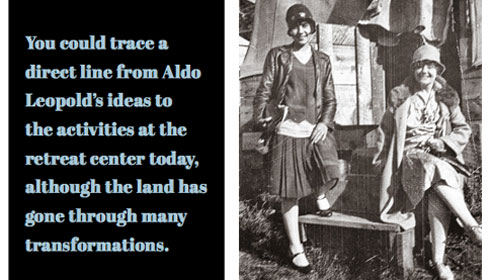 On vacation in the flapper era, ca. 1928.
On vacation in the flapper era, ca. 1928.
Guests stayed in large tent cabins, sturdily built on raised platforms of milled lumber. Pictures of women in long dresses standing beside the tents, smiling in their flapper garb, reveal a carefree casualness among his visitors that would have been unthinkable to homesteaders or their predecessors in this remote landscape. For several years under Baxter’s ownership, the Kit Carson Camp for Boys also used the Vallecitos property. The boys no doubt splashed in the swimming pool Baxter built in the meadow below the lodge—another sight that would have startled Sibley.
Baxter sold the land in 1951, and it passed through several more owners, who used it as a hunting-and-fishing getaway. Then, in 1969, Harvey Mudd, a writer and the director of an environmental organization in Santa Fe, stumbled across the lodge while backpacking. Mudd was taken by the beauty and solitude of the place and soon persuaded the owners to part with the property.
Mudd had recognized immediately that this was no ordinary land. Through it flowed a stretch of the Vallecitos River and most of a tributary, Rock Creek, which previous owners had dammed to form the ponds. Surrounding the central meadow where the homestead cabin, lodge, and other structures stood were forests of pine and mixed conifers and groves of quaking aspen. The ponds and natural springs fed marshy wetlands that offered a haven for birds and other wildlife. On the property stood some of the largest, oldest ponderosa pines left in the mountains.
Taking a 180-degree turn from the hunting-lodge idea, Mudd designated the property, which he called El Vallecito Ranch, a wildlife refuge, and declared it gun-free. He fixed dilapidated fencing, repaired the lodge, and set out to restore the land to health by reseeding it with native grasses, planting berry patches, and restoring the decaying irrigation system.
While Mudd was writing and working at the ranch and running his environmental organization, he met the man who would ultimately transform the ranch into a retreat center. Mudd recalls that Grove Burnett, a newly minted environmental lawyer, simply walked into his office in 1971 and offered to help Mudd’s organization. Mudd hired him, and Burnett, along with his wife at the time, Linda Velarde, began to spend time at the ranch with their two children. It became a haven for both families.
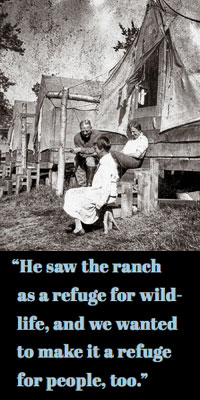 Guests at the former sleeping cabins in the 1930s
Guests at the former sleeping cabins in the 1930s
When, in 1992, Mudd found himself in financial difficulties, he sold the ranch to Burnett and Velarde and two friends (philanthropists who wanted to remain anonymous), who created a nonprofit corporation, assembled a board of directors, and set out to realize their vision for the property.
“We were clear from the beginning that we wanted to make a refuge and retreat center for meditation,” says Burnett, the founding teacher at the Vallecitos Mountain Refuge, as it was initially called. “Basically, we wanted to expand on Harvey’s vision; he saw the ranch as a refuge for wildlife, and we wanted to make it a refuge for people, too.”
We walk slowly in single file along the river, alert to sights, sounds, and smells around us. We stop abruptly when movement ahead catches our eyes. A large wild turkey passes, wraithlike, across the wooded hillside, floating—not quite in flight, not quite running—and disappears from our sight.
Burnett says that as the board began to formulate a plan, they kept coming back to the words of Henry David Thoreau, who in 1854 wrote, “I went to the woods because I wished to live deliberately, to front only the essential facts of life, and see if I could not learn what it had to teach, and not, when I came to die, discover that I had not lived.”
“Those words were the cornerstone of our philosophy,” Burnett says. “We wanted to create a sanctuary for people to take refuge. It was as simple as that. That was our guiding principle, and it has remained so for the last 25 years.”
In 1994 the first retreat, for environmental leaders from around the country, was led by the renowned meditation teacher Joseph Goldstein, who was also on the founding board of directors. It was Goldstein who recommended that the board steer clear of making Vallecitos a Buddhist center. They heeded his counsel, and the refuge remains rooted in teaching dharma meditation—but as secular, mindfulness training.
The facilities started out simply, with small tents clustered behind the lodge to provide shelter for the “yogis,” as retreat participants are called. Soon, though, the organization began to build the small cabins, or casitas, a large “mama yurt,” an isolated cabin for visitors wanting more solitude, and a bathhouse. The board also beefed up the legal protection for the property, signing a conservation easement in 2006 that prohibits subdivision of the land and disallows new building beyond the existing footprint.
Thousands of people have gone to Vallecitos Mountain Retreat Center to participate in retreats that focus on “mindfulness and meditation grounded in a direct experience with nature and wilderness.” The center attracts well-known teachers with diverse backgrounds from all across the country to lead retreats with titles such as “The Wisdom of No Technology,” “Love and Wisdom Retreat,” and “Turning to Deeper Soils: Yoga, Meditation, Hiking, and Heart.”
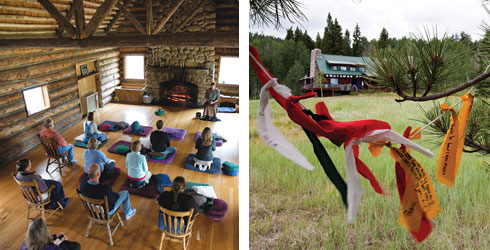 In the meditation hall. Prayer flags frame a view of the main lodge.
In the meditation hall. Prayer flags frame a view of the main lodge.
The combination of wilderness with mindfulness meditation makes for a heady brew. On a given day, there might be a reading from the Tao Te Ching or a poem by Mary Oliver, a quote from the Zen master Dogen or Gary Snyder—or there may be no words at all, for days at a time, as groups participate in silent retreats. A visitor might be immersed one moment in the bliss of wild nature while contemplating a half-century-old ponderosa—and then have the tranquillity shattered by the violence of a bobcat taking down and devouring a doe, as one stunned group of visitors witnessed earlier this year.
Thomas Sibley surely wouldn’t have imagined his homestead being used this way, but its incarnation as a retreat center reflects changes in the perceptions of New Mexico’s unpeopled landscapes, from places for brazen exploitation to places for personal engagement with what remains of wildness.
After our retreat, as we talked for the first time, we yogis agreed that our time at the retreat center gave us a more thorough immersion in “the woods” than we would have felt without the meditation, the silence, the focused awareness. It had cultivated in us a capacity for attention that made a simple reflection of water on rocks into a marvelous vision. We felt reenergized and ready to return to our workaday lives with a new perspective, with a greater ability to hold close to each moment, wherever we may be.
—Don Usner Disclosure: The author leads retreats at the center on a volunteer basis.
Dropping Out, Tuning In
NM RETREAT CENTERS
Vallecitos Mountain The Vallecitos Mountain Retreat Center offers a wide range of retreats and workshops that focus on mindfulness and meditation in a wilderness setting. From all around the country, both participants and teachers are drawn to this unique refuge in the Tusas Mountains(505-469-9017; vallecitos.org). But numerous retreat centers in other parts of New Mexico—often boasting open spaces, clear skies, and wild, untrammeled land—also attract those in search of some time for reflection.
Ghost Ranch The red and yellow mesas and cliffs of O’Keeffe country provide inspiration—and lots of hiking and horseback-riding opportunities—at this internationally renowned retreat and workshop destination. Lodging is available for attendees of Ghost Ranch’s year-round programs. 1708 US 84, Abiquiú; (505) 685-1000; ghostranch.org
Kadampa Meditation Center New Mexico A Buddhist refuge from the hustle and bustle of daily life sits right in the heart of Albuquerque. There are weekly drop-in meditation sessions, study programs, and retreats—all offered throughout the year. Limited accommodations are available for out-of-town participants. 8701 Comanche Rd. NE, Albuquerque; (505) 292-5293 ;meditationinnewmexico.org
Lama Foundation Close to Taos and Carson National Forest, this residential community, which draws upon various spiritual practices, offers summertime retreats and special observances to the public. Lodging is available—in one of two fanciful little structures—for guests who come from out of town. 1895 Lama Mountain Rd., Questa; (575) 586-1269; lamafoundation.org
The Mandala Center This spiritual retreat compound in northeastern New Mexico’s beautiful, remote Union County is near Capulín Volcano National Monument. A wide range of workshops and retreats are offered each month, and private retreat weekends can be accommodated. Lodging is available in two roomy guesthouses. 96 Mandala Rd., Des Moines; (575) 278-3002; mandalacenter.org
Monastery of Christ in the Desert Founded in 1964 and designed by famed architect and woodworker George Nakashima, this Benedictine monastery in the Chama Canyon wilderness offers its guesthouse all year long to both men and women seeking a private retreat; there are also scheduled twice-monthly weekend retreats centered around such themes as silence and nature. Forest Road 151, Abiquiú; (575) 613-4233; christdesert.org
Ocamora Retreat Center In the Sangre de Cristos eastern foothills, this 265-acre spread is all about rustic charm and summertime programs that span many meditative and learning traditions, including those in the creative and healing arts. Ocamora also offers children’s camps. Accommodations include two private compounds, one set in a century-old apple orchard, and two yurts. 43 Canyon Bonita St., Ocate; (575) 666-2389; ocamora.org
Our Lady of Guadalupe Abbey Twenty-five miles east of Santa Fe, the Pecos Benedictine monastery nestles in the lush Pecos River canyon, on ranchland that was established as a monastery in 1948. Both men and women can book its simple but comfortable guest quarters any time of the year for either private or group retreats; the monastery itself offers occasional workshops in such things as making retablos. The first Monday every month, the public is welcome at an evening healing service called the Taizé prayer, the sung meditation that began in a French village of the same name. 16 Guadalupe Lane, Pecos; (505) 757-6415; pecosmonastery.org
Upaya Zen Center This Zen Buddhist meditation campus on five beautifully tended acres just 10 minutes from Santa Fe’s historic Plaza offers daily meditation sessions and weekly dharma talks, personal retreats, and special programs year-round. The center’s abbot is Roshi Joan Halifax, internationally known for her work in Buddhist teachings. Overnight accommodations are simple but elegant. 1404 Cerro Gordo Rd., Santa Fe; (505) 986-8518; upaya.org


